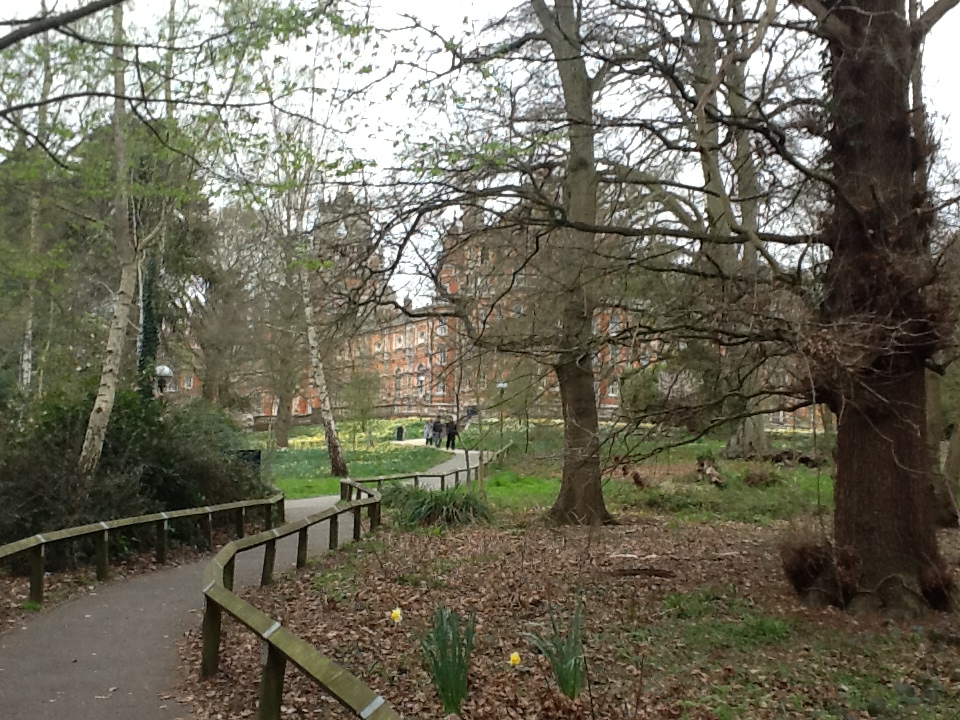 Today marks the end of the 13th International Conference on Neuronal Ceroid Lipofuscinoses (NCL) at the University of London’s Royal Holloway College. That means this is also my last “Notes from London” post.
Today marks the end of the 13th International Conference on Neuronal Ceroid Lipofuscinoses (NCL) at the University of London’s Royal Holloway College. That means this is also my last “Notes from London” post.
Mom walked this path from her dorm room to the conference center and back again many a time in the past few days. She submitted her final update to me just before the closing banquet and her final climb up the path.
I learned a lot about the setting for this conference – so unlike the nondescript, cookie-cutter American hotels to which we’re so accustomed, via Mom’s final update.
“I went to breakfast the first day and haven’t been back since,” she writes. “No problem with the food – best porridge ever – but I’ve been trying to catch up on sleep. As for the other meals…this is a college, so the proportions are gigantic and I’ve not suffered for lack of carbs. The traditional “pub” dinner was interesting. Fish and chips (HUGE piece of fried fish! May I have mine grilled, please? What???), mashed potatoes, Toad in the Hole (ah, no).” At the end, they served Treacle Tart, a “very traditional” dessert. “Oh, I’ve had that before – it’s Chess Pie!” Mom said, to which the server responded, “No, it’s Treacle Tart.” Last night’s theme was curry – curried chicken, curried lamb, curried rice, curried veggies. Mom didn’t comment on the curry – but she went out of her way to say she enjoyed the salad bar!
Mom wanted to be on time for this morning’s session highlighting emerging and novel therapies for the various forms of NCL (Batten disease), so she ran up the hill. Most of the therapies focused on infantile NCL (the form that affects Taylor) and late infantile NCL, both of which are caused by deficiencies in soluable enzymes. The following therapies were of particular interest for Mom:
- Dr. Mark Sands from Washington University in St. Louis described his recently published project demonstrating the synergistic effect of combining gene therapy and bone marrow transplantation for infantile NCL. The data is incredible, and the work MUST go forward.
- Dr. Sandra Hofmann of the University of Texas Southwestern in Dallas presented data for her enzyme replacement therapy project. To date, Taylor’s Tale has directly contributed $230,000 to this specific project. In the coming year, Dr. Hofmann and Dr. Sands will collaborate in order to expand the reach of their projects.
- Dr. Steven Gray of the University of North Carolina at Chapel Hill presented a gene therapy platform that may work for multiple Batten disease gene therapy approaches (i.e. infantile AND late infantile NCL). Interestingly, it requires an intrathecal injection – which is a routine, non-surgical procedure with minimal complications. Dr. Gray’s work is very interesting, and as a North Carolina-based non-profit organization, we love that it is happening in our own backyard.
- Several experts presented on enzyme replacement therapy for late infantile NCL. This work is very close to clinical trial. They showed videos of the long-haired dachshunds in the canine study (yes – dachshunds, too, get Batten disease). The dogs were in the end-stages of the disease and, of course, very sick. They suffered from persistent myoclonic jerks, mental abnormalities, loss of visual tracking, inability to eat…the list goes on. It painted a heartbreaking picture, and Mom saw many faces turn away from the screen and heard many moans of distress among the audience. And yet – the terrible images on the screen did not represent a Hollywood-manufactured horror film. They represented the very real picture of children with this disease. If it breaks our hearts to see it in an animal, what are we going to do about getting behind the incredible scientists who gathered in London this week and help them end the horrors happening in children like my sister, Taylor?
I have so much hope for the future. Many thanks to those at King’s College London, the Batten Disease Family Association based here in the UK, and others for organizing this tremendously valuable conference. The 14th International Conference on Neuronal Ceroid Lipofusinoses (Batten Disease) will be held at the National University of Cordoba in Argentina. Best of luck to all of the scientists as they head back to their labs. It is with great hope that I look forward to meeting you all again in Argentina to hear of successes in the battle against Batten. I, and many other families, are counting on you.
